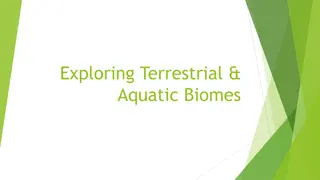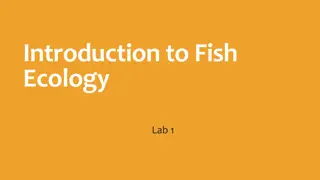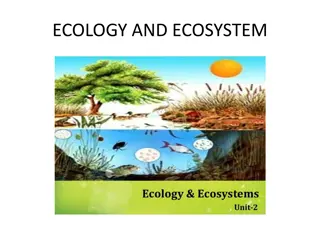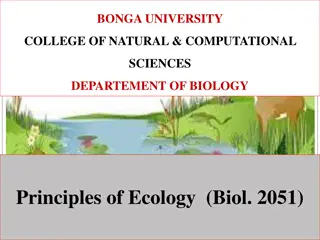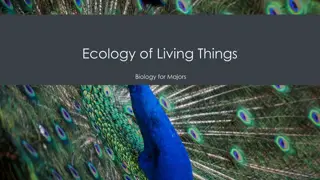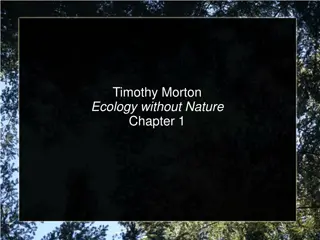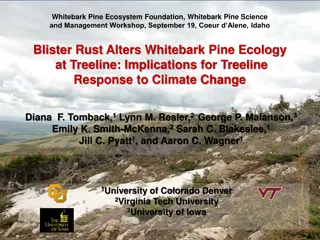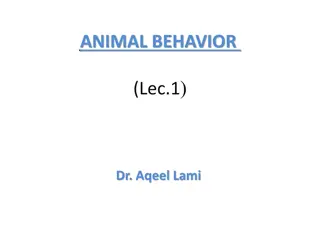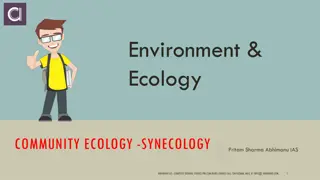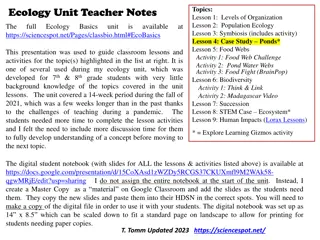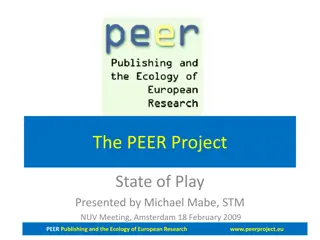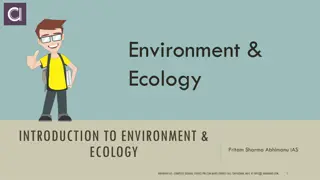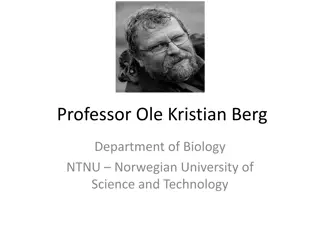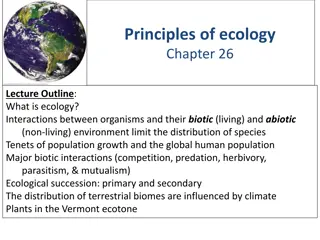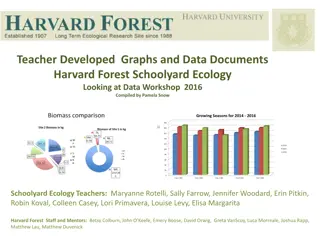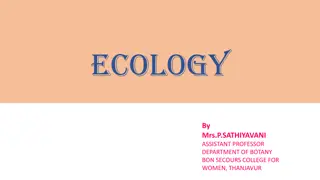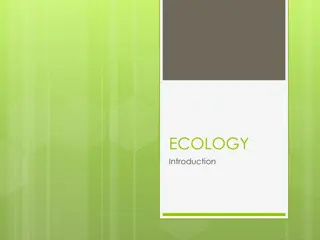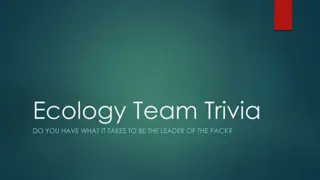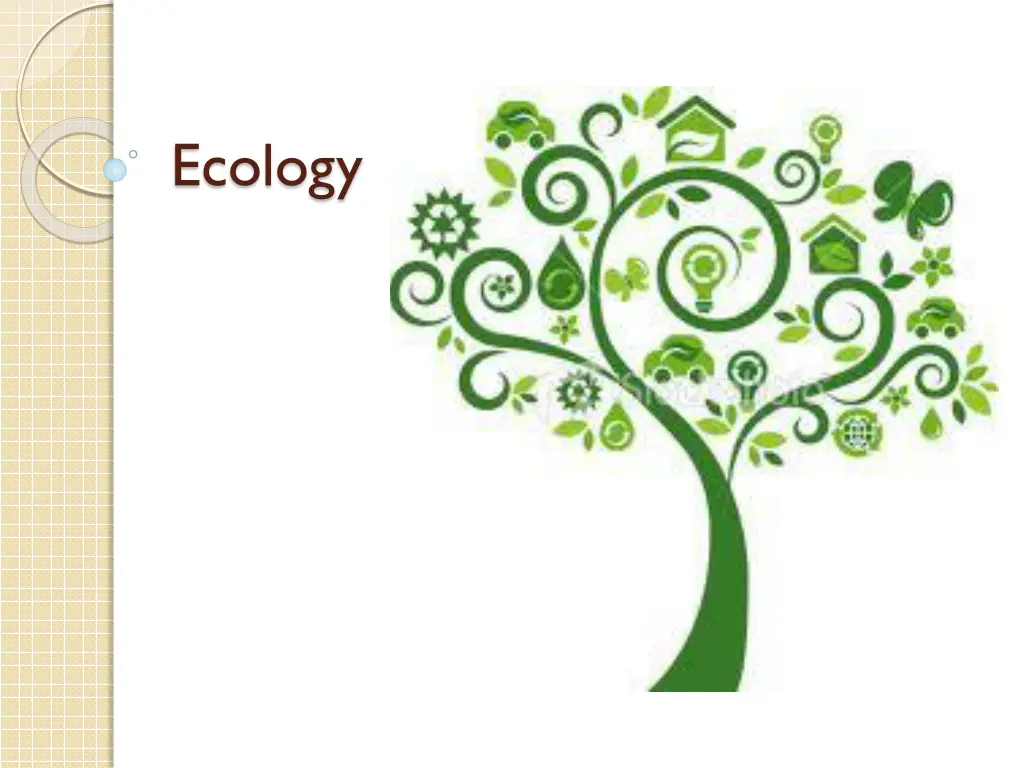
Understanding Ecology: Interactions in Nature
Explore the intricate web of interactions between organisms and their environment in ecology. From ecosystems to habitats and populations, learn how all living and nonliving components shape our world. Discover the role of biotic and abiotic factors in maintaining the delicate balance of nature.
Download Presentation

Please find below an Image/Link to download the presentation.
The content on the website is provided AS IS for your information and personal use only. It may not be sold, licensed, or shared on other websites without obtaining consent from the author. If you encounter any issues during the download, it is possible that the publisher has removed the file from their server.
You are allowed to download the files provided on this website for personal or commercial use, subject to the condition that they are used lawfully. All files are the property of their respective owners.
The content on the website is provided AS IS for your information and personal use only. It may not be sold, licensed, or shared on other websites without obtaining consent from the author.
E N D
Presentation Transcript
Overview Earth is home to trillions of different organisms None can survive alone All organisms must interact with the living and nonliving things around them Ecology = the study of how organisms interact with the living and nonliving things that surround them.
Organisms and Their Environment Just sitting here you are surrounded by and interacting with the environment What are you interacting with right now? The environment is every nonliving and living thing surrounding you
Parts of an Ecosystem Ecosystem is a short way of saying ecological system Used to describe any portion of the environment Made up of all living things: Bacteria, plants, animals These living things = biotic factors We also study nonliving things Soil, water, physical space, and energy These nonliving things = abiotic factors
Parts of an Ecosystem There are many types of ecosystems. Decaying log, a pond, a field of corn, a fish tank In every ecosystem, organisms interact with both the biotic and abiotic parts of the environment Example: Frogs in a pond are affected by Insects, fish, hawks, children Rainfall, acidity of the pond, temperature, and amount of light
Parts of the Ecosystem There are many different environments that are available for organisms Some species may only live in one environment Their home A specific environment for an organisms is known as its habitat Example: Field, forests, oceans, streams, deserts The role an organism plays in an environment = niche
Parts of the Ecosystem All of the organisms of a species that live in the same area make up a population Example: Ants in an anthill = one population Different populations are combined to form communities
Parts of the Ecosystem All of the Earth s ecosystems make up a biosphere Biosphere = biologically inhabited portions of the planet The earth s biosphere extends from the deepest ocean troughs to the highest peaks of mountains Includes all water, land, and air that organisms can live in Organisms interact and compete for vital resources Food, space, shelter
Parts of the Ecosystem The fundamental concept of ecology = all living organisms are interdependent They interact with one another and with the physical environment The interactions result in a flow of energy and a cycling of materials essential for life
Environmental Limits on Population Size The growth and survival of organisms depends on the physical conditions and on the resources available to an organism If there were unlimited resources, living things could produce populations of infinite (unlimited) size In an ecosystem, resources are finite (limited) Resources = oxygen, carbon dioxide, water, nutrients, space, and sunlight Because resources are finite, organisms must compete for resources
Environmental Limits on Population Size Competition = struggle for resources among organisms Competition keeps the size of the species population in check (balanced) Populations tend to increase or decrease depending on the resources available at the time It tends to follow a cycle May follow the seasons The size of population remains stable
Environmental Limits on Population Size Limiting factors = factors in the environment that limit the size of the population Some are abiotic, others biotic Abiotic factors = oxygen, sunlight, intensity of light, temperature, water, minerals, type of rocks or soil, acidity Biotic factors = predator vs prey relationship, Predator = hunter; prey = hunted Too many predators, not enough prey the population of predators will start to starve
Environmental Limits on Population Size The number of organisms of a single species that an ecosystem can support = carrying capacity Determined by available energy, water, oxygen, and minerals, interactions with organisms Example: a fields carrying capacity of foxes is affected by: Climate, number /kind of populations present (viruses, prey), The population will increase until carrying capacity is reached.
Types of Carrying Capacity Natural Carrying Capacity Limited by the available biotic and abiotic resources Social Carrying Capacity Determined by the number of organisms people want or will tolerate
Environmental Changes Dynamic Equilibrium Constantly changing stable state where populations fluxuate on either side of an average Biomass The amount of living material in a given time It can refer to one or several species
Population Interactions Many species interact in an ecosystem Most occur when obtaining food Populations are linked either directly or indirectly with other populations Each population can have one or more specific role in an ecosystem Maintaining diversity in the ecosystem is essential to its stability
Roles in an Ecosystem The role that each species plays in an ecosystem = ecological niche Only one organism can occupy a particular niche at a time If 2 species try to fill the same role in an ecosystem, competition results One organism will be a better competitor than the other/ better suited, it forces the other to move or is eliminated Over time only one organism will occupy each niche
Roles in an Ecosystem It might appear as if different population occupy the same niche but they are indeed different Example: deer and moose. They live in the same area and both eat plants. The plants they prefer are different though. There is only competition when food is scarce Example: Birds may all live in the same tree and eat insects but each bird will live and eat in a different part of the tree
Roles in an Ecosystem Competition for a particular niche often occurs when a foreign species enters an area The new species may be more successful than the native species The new species may not have an enemies to control its population Humans often introduce many foreign species Example: zebra mussles in the great lakes, brought by cargo ships, have become a big problem
Relationships in an Ecosystem In ecosystems, populations of different species are linked by complex webs of interactions Sometimes the relationship is competitive; sometimes they are cooperative Example: termites have uni-cellular organisms in their intestinal tracts that digest their food The organism has a place to live (in the termite) and plenty of food, and it helps the termite gain nutrients
Relationships in an Ecosystem Other relationships help one but have no effect on the other Example: a shark attacks and eats its prey. Small fish swim below the shark and eat up the left-overs. The fish benefit but the shark is unaffected
Food Chains Predator-Prey relationships are the most common relationships Food chains, show the relationship between predator and prey relationships It shows what eats what
Food Chains Organism s niches are partly defined by how they gather food Example: photosynthetic organisms make their own food and store energy (from the sun) These organisms = autotrophs (self-feeders) or producers They provide food energy for almost all other living things
Food Chains Hetertrophs = acquire food by consuming other organisms Herbivores = hetertrophs that survive on plants Carnivores = hetertrophs that eat other animals Hetertrophs are known as consumers
Food Chains The wastes and dead bodies of organisms are consumed by decomposers Decomposers recycle materials that can then be reused by producers
Food Chains There are two relationships that do not fit the normal predator-prey relationship They feed on other organisms but do not kill it to feed themselves Scavengers = are consumers that eat dead organisms (vultures) Nature s clean-up crew, not decomposers though
Food Chains Dead bodies and wastes still have to be broken down by decomposers Parasites are organisms that attack other live organisms (host organisms) Rarely kill them Parasites usually live on or in the body of their hosts Ticks live on a dog and feed on its blood
Food Chains Food chains generally begin with autotrophs and end with hetertrophs and are eventually consumed by decomposers Food chains can be very simple or very complex Decomposers may or may not be included but we must remember they break down the wastes and dead bodies of all living organisms
Food Webs Normally each organism feeds on more than one kind of organism Organisms have more than one food source Food chains are oversimplified, food webs are food chains connected together (more complex) Because organisms can eat many things, ecosystems remain stable even when one population shows a major decline in numbers Organisms that feed on declining populations rely more heavily on other food choices until the population recovers
Energy Flow Through an Ecosystem Almost all organisms use the solar energy stored in food to power their life processes The energy can t remain in the organism forever An organism is constantly losing energy, it is breaking bonds in food to use the energy to live The energy is used to make ATP then used in cells. Lots of energy is used as heat and is lost to the environment This means each step in the food chain has less energy than the previous organism
Energy Flow Through an Ecosystem Most of the energy originally gained from the sun is lost (used) by that organism. Only 10% of the original energy is passed on to the next organisms Only 10% of the energy it gained is passed on to the next organism This means food chains are normally quite short
Energy Flow Through an Ecosystem Energy Pyramid = a diagram that illustrates the transfer of energy though a food chain or web Each block represents the amount of energy that was obtained from the organism below it Each level is smaller due to the loss of heat as the organisms carry on their life activities
Energy Flow Through an Ecosystem A continual input of energy (mostly from sun) is required to start the process and to keep it going Producer organisms capture this energy and store it in chemical bonds of the food molecules they make The flow of energy that accompanies the transfer of food is essential to life Even though we are constantly losing energy, the sun continues to provide more, continuing life
Recycling and Reusing Materials Parts of dead organisms are not consumed during any of the steps of a food chain. Decomposers extract the last bit of energy contained in the dead organisms and energy in waste products to sustain their life functions When they do this, the raw materials contained in the once-living matter is transferred to soil = decomposition
Recycling and Reusing Materials Decomposers = bacteria and fungi Due to decomposers, atoms and molecules in living things cycle through both nonliving and living parts of the biosphere Through this they pass through the food chain Example: Plants use carbon dioxide and water and store it as glucose, when the plant is eaten the glucose is broken down and used within the organism. The organism may release carbon dioxide and water in respiration Much of this cycling in the ecosystem is done by decomposers
Energy Flow Sunlight plants Primary consumer secondary consumer tertiary consumer decomposers Or Sunlight autotrophs heterotrophs decomposers Or Sunlight producers herbivores/omnivores carnivores/omnivores decomposers All start with _________ & end with __________
Risks within Food Chains Bioaccumulation toxins accumulate in greater concentrations as your progress up a food chain
Relationships in Ecosystems Producer Consumer Decomposer Predator Prey Parasite Host Pinworm, tapeworm, bot fly, leech, tick, mosquito, lamprey, chigger, tomato worm wasp, fleas Scavenger Dead Things
Types of Relationships Symbiotic Relationships Clown fish and anemone Birds and buffalo Hummingbirds and flowers Fig and wasp
Diversity Benefits Species and Habitats As a result of evolution, there is a great diversity of species on Earth Each ecosystem is populated with many species which occupy their own niche The relationships of these populations keep the ecosystem stable and the diversity of species increases the chance that at least some organisms will survive in the face of large environmental changes
Diversity Benefits Species and Habitats Biodiversity = measurement of the degree to which species vary within an ecosystem There is a connection between biodiversity and stability of the ecosystem Example: a forest has many trees, if there is a disease, it will not kill all the trees in one area. Disease and insect infestation are resisted by biodiversity.
Diversity Benefits Species and Habitats Interactions between organisms may allow an ecosystem to remain stable for thousands of years In ecosystems populations tend to increase and decrease in size in a predictable pattern Overtime, the population size stays stable Example: Increase in predator or prey population
Diversity Benefits Species and Habitats The loss of biodiversity in an ecosystem upsets its stability Removing species from an environment often causes instability due to the loss of organisms that were filling critical ecological niches
Diversity Benefits Species and Habitats Many species may be lost when natural disasters or human activities cause large- scale destruction of habitats Example: Destruction of rain forests, some organisms may be able to return to a damaged ecosystem, others may not be able to return The interactions between populations will be lost
Diversity Benefits Species and Habitats Species can be lost when humans do not consider their impact on the ecosystem Example: Human hunting of mountain lions Led to overpopulation of deer Led to overgrazing of grass lands Led to deer starving and soil erosion that caused permanent environmental damage
Diversity Benefits Species and Habitats When land is cleared for agricultural purposes, the loss of biodiversity may cause an unstable ecosystem When plants are genetically similar it can lead to problems with diseases and bugs This is avoided with natural biodiversity Less likely one pest or disease would destroy the environment
Biodiversity Benefits Humans Biodiversity is a great resource for humans as well It ensures the availability of a rich variety of genetic material Some that could be valuable to humans Genetic diversity found in rain forests could provide humans with medicines, insecticides, and other useful resources If we destroy these ecosystems, we could be destroying solutions to our problems
Biodiversity Affected by Humans Urban Sprawl Minimizing biodiversity by putting up structures Ecosystems are dynamic Always changing Does not balance out and reach a steady state
Environmental Changes Many environments have few resources that can provide home for living organisms These environments will naturally change over long periods of time to become habitats with many diverse species The series of changes when one habitat changed into another = ecological succession


